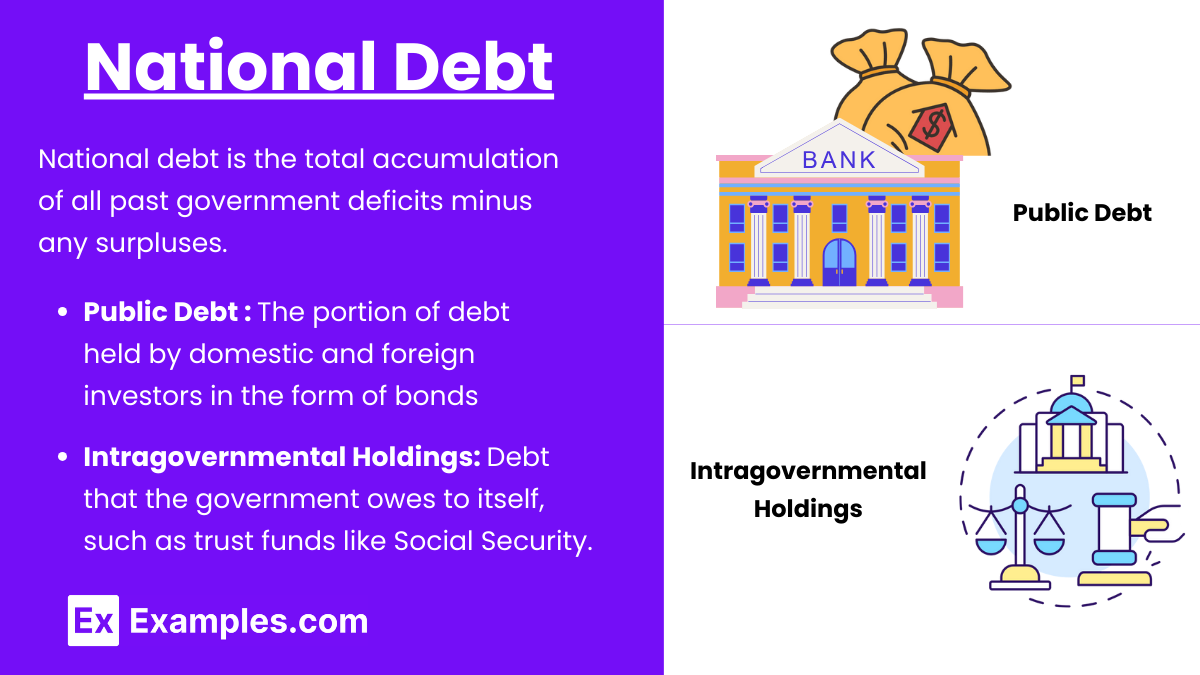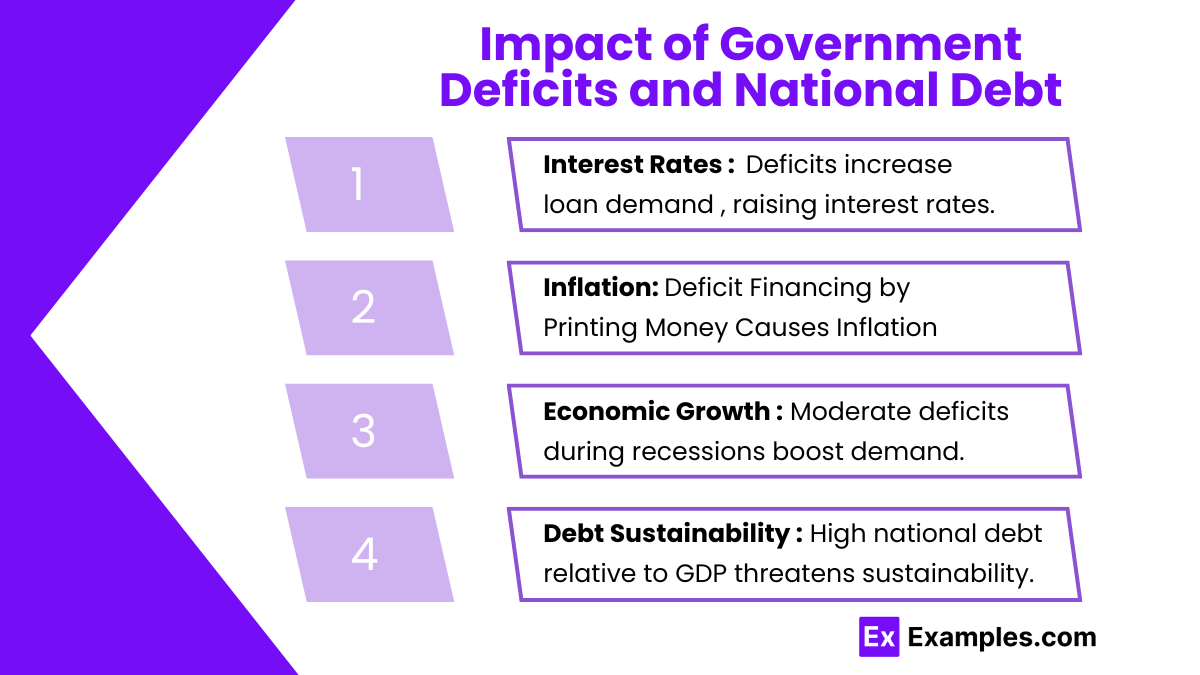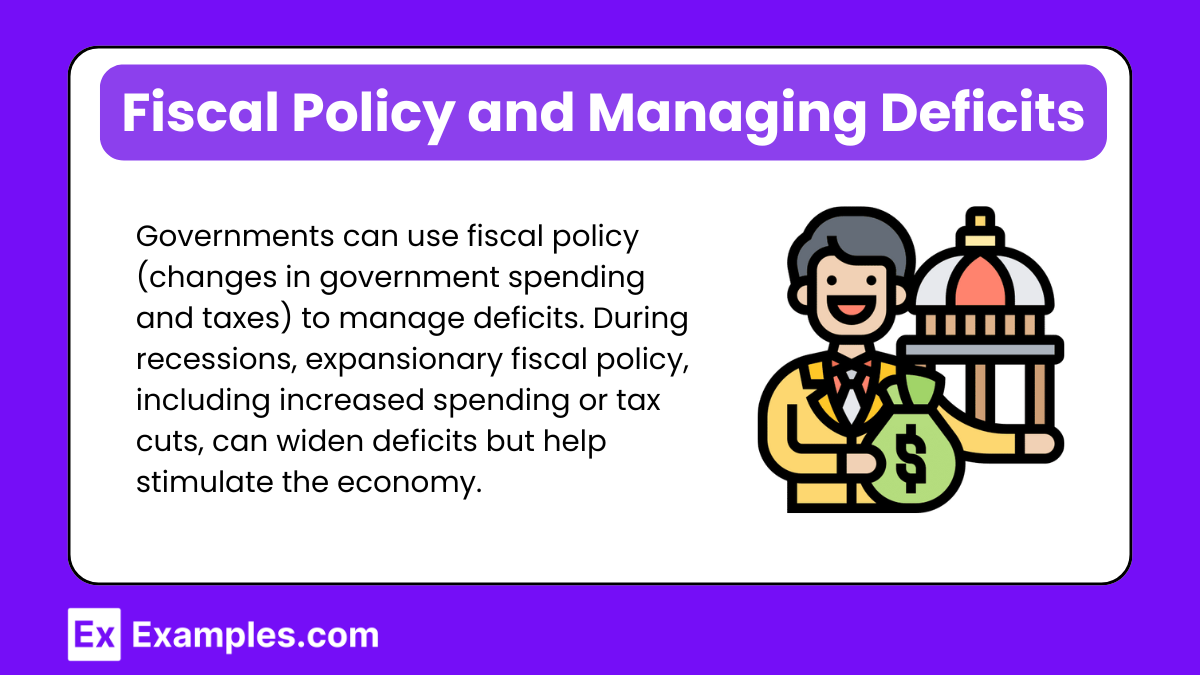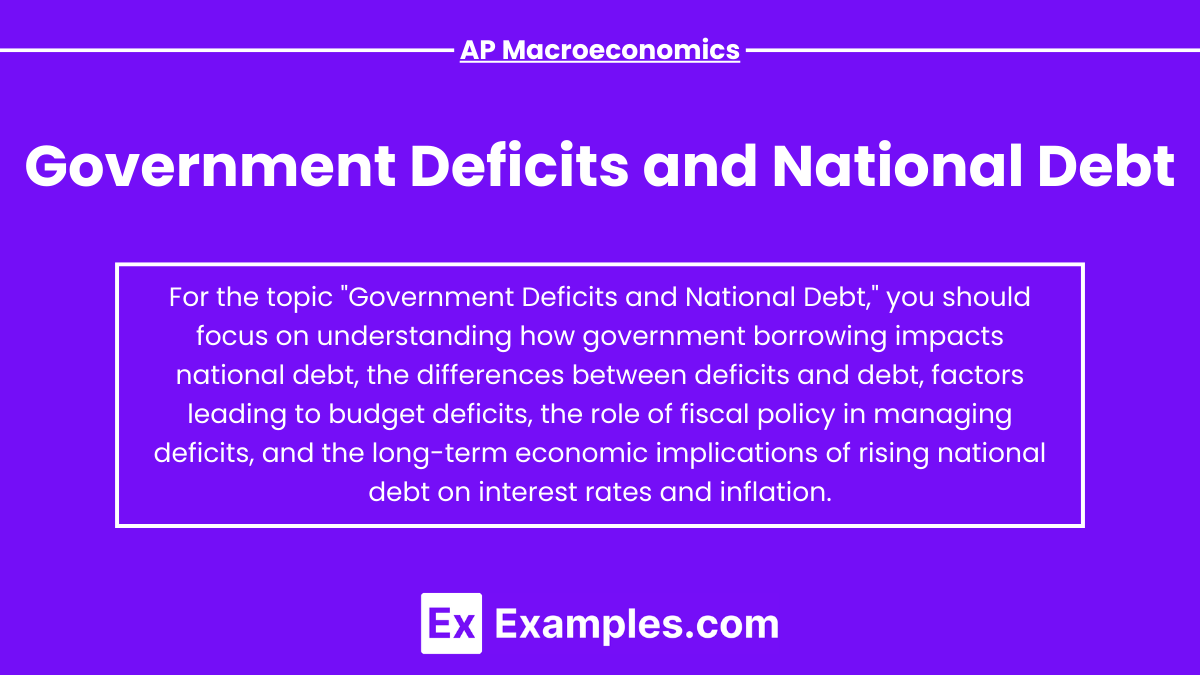Government deficits and national debt are critical concepts in fiscal policy and macroeconomic analysis. A government deficit occurs when spending exceeds revenue in a fiscal year, while national debt is the total amount owed from accumulated deficits over time. In AP Macroeconomics, these topics help students understand how borrowing, debt management, and fiscal responsibility impact economic stability. Examining the consequences of deficits and debt is crucial for analyzing government policies, interest rates, inflation, and the broader effects on economic growth.
Learning Objectives
In studying Government Deficits and National Debt for AP Macroeconomics, you should understand the distinction between deficits and debt, how deficits contribute to the accumulation of national debt, and the economic implications of both. Focus on how government borrowing affects interest rates, inflation, and overall economic growth. Learn the causes of deficits, the sustainability of national debt, and the role of fiscal policy in managing debt. Additionally, grasp the long-term consequences of persistent deficits and the balance between stimulating growth and maintaining fiscal responsibility.
Introduction
In AP Macroeconomics, understanding the concepts of government deficits and national debt is crucial for analyzing fiscal policy, economic growth, and financial stability. A government deficit occurs when a government’s expenditures exceed its revenues in a given fiscal year, leading to borrowing and an increase in national debt. The national debt is the cumulative amount of money the government owes, both domestically and internationally. These concepts are interconnected and significantly impact the economy, influencing interest rates, inflation, and future fiscal policy decisions.
Government Deficits

A government deficit happens when the government’s spending surpasses its income from taxes and other revenues. Deficits can be classified into two types:
- Structural Deficit: Occurs when the deficit exists even during periods of economic growth, typically resulting from long-term spending policies that outpace revenue collection.
- Cyclical Deficit: Arises from temporary economic downturns, such as recessions, where government revenues decline (due to reduced tax collections) while spending increases (due to unemployment benefits, stimulus programs, etc.).
The government covers deficits by borrowing, typically through the issuance of bonds. This borrowing adds to the national debt.
Causes of Deficits
- Increased government spending on programs like healthcare, defense, and social security.
- Tax cuts that reduce revenue without a corresponding decrease in government spending.
- Economic recessions that reduce tax revenue and increase automatic stabilizers like unemployment benefits.
National Debt

National debt is the total accumulation of all past government deficits minus any surpluses. It can be divided into two categories:
- Public Debt: The portion of debt held by domestic and foreign investors in the form of bonds. Public debt includes all debt held by individuals, corporations, state or local governments, and foreign entities.
- Intragovernmental Holdings: Debt that the government owes to itself, such as trust funds like Social Security. Intragovernmental holdings represent funds owed by one part of the federal government to another.
National debt is a more comprehensive measure than annual deficits, as it reflects the total financial obligations the government must eventually repay.
Impact of Government Deficits and National Debt

- Interest Rates: When governments run deficits and borrow more, they increase the demand for loanable funds, which can push interest rates higher. Higher interest rates can “crowd out” private investment, potentially slowing economic growth.
- Inflation: If deficits are financed by printing more money, this can lead to inflation. However, in many modern economies, governments borrow by selling bonds rather than printing money.
- Economic Growth: Moderate deficits during recessions can stimulate economic growth by boosting demand. However, persistent, large deficits can harm long-term growth by increasing debt servicing costs and reducing the resources available for productive investments.
- Debt Sustainability: If national debt grows too large relative to GDP, it can become unsustainable. Governments may struggle to pay interest on the debt, leading to the risk of default or inflationary pressures from money printing.
Fiscal Policy and Managing Deficits

Governments can use fiscal policy (changes in government spending and taxes) to manage deficits. During recessions, expansionary fiscal policy, including increased spending or tax cuts, can widen deficits but help stimulate the economy. During periods of growth, contractionary policies, such as reducing spending or increasing taxes, can help reduce deficits and control the growth of national debt.
Some countries have adopted fiscal rules to limit the size of deficits and control debt, such as balanced budget requirements or debt ceilings.
Examples
Example 1: United States 2008 Financial Crisis
During the 2008 financial crisis, the U.S. government implemented large-scale fiscal stimulus programs, including the Troubled Asset Relief Program (TARP) and the American Recovery and Reinvestment Act (ARRA). These efforts aimed to stabilize the economy but significantly increased the federal deficit. As a result, the national debt rose sharply as the government borrowed to finance the stimulus.
Example 2: Japan’s High National Debt
Japan has one of the highest national debts in the world, exceeding 200% of its GDP. This debt accumulation is primarily due to decades of deficit spending to support social programs, infrastructure development, and stimulus measures, particularly after the burst of Japan’s asset bubble in the early 1990s. Japan’s aging population and high public pension spending continue to strain its fiscal balance.
Example 3: Eurozone Sovereign Debt Crisis
Countries like Greece and Spain experienced severe deficits and debt crises after the 2008 financial crisis. Greece, in particular, saw its national debt skyrocket as a percentage of GDP, leading to the country’s reliance on bailout packages from the European Union and the International Monetary Fund. These deficits were caused by a combination of high government spending and low tax revenues.
Example 4: World War II U.S. Deficits
During World War II, the U.S. government ran large deficits to finance military expenditures. The national debt rose dramatically as the government issued war bonds to cover the costs of the war effort. However, after the war, a booming economy and inflation helped reduce the debt-to-GDP ratio over time.
Example 5: Argentina’s Debt Crisis (2001)
Argentina’s national debt crisis in 2001 was triggered by a combination of chronic deficits, high interest payments on loans, and a fixed exchange rate policy that worsened the country’s fiscal position. The government defaulted on its debt, leading to a financial crisis, which required major restructuring of the debt and years of austerity measures to restore fiscal stability.
Multiple Choice Questions
Question 1
When a government experiences a budget deficit, it must:
A) Print more money to cover the shortfall
B) Borrow funds by issuing bonds
C) Cut government spending immediately
D) Increase taxes to eliminate the deficit
Recommended Answer: B) Borrow funds by issuing bonds
Explanation: A budget deficit occurs when government expenditures exceed revenues. To finance the deficit, governments typically issue bonds to borrow money from the public or foreign investors. This is a common practice as it allows the government to continue its spending without needing to immediately cut spending or raise taxes. Printing money (Option A) is rarely a policy used in modern economies because it can lead to inflation. Immediate spending cuts (Option C) or tax increases (Option D) are not always politically or economically feasible and are generally not used as short-term solutions.
Question 2
Which of the following is a consequence of persistent government budget deficits?
A) Decrease in national debt
B) Increase in private sector investment
C) Higher interest rates due to increased borrowing
D) Deflation due to decreased government spending
Recommended Answer: C) Higher interest rates due to increased borrowing
Explanation: Persistent budget deficits lead to higher national debt because the government must continually borrow money to cover its shortfall. As the government borrows more, the demand for loanable funds increases, which can push up interest rates (Option C). This can crowd out private sector investment because higher interest rates make borrowing more expensive for businesses. Option A is incorrect because deficits add to national debt. Option B is incorrect because higher interest rates tend to reduce private investment, not increase it. Option D is incorrect because government deficits often lead to inflationary pressures rather than deflation.
Question 3
If a country’s national debt grows faster than its GDP over time, which of the following is likely to occur?
A) The debt-to-GDP ratio will decrease
B) The country’s ability to repay its debt will improve
C) The country may face difficulties in servicing its debt
D) Interest payments on the debt will decrease
Recommended Answer: C) The country may face difficulties in servicing its debt
Explanation: If the national debt grows faster than GDP, the debt-to-GDP ratio increases, indicating that the country’s debt burden is becoming more unsustainable. As the debt rises, the government may face difficulties servicing it, especially if interest rates also rise. This can lead to higher interest payments and increase the risk of default. Option A is incorrect because the debt-to-GDP ratio would increase, not decrease. Option B is incorrect because the country’s ability to repay its debt worsens when debt grows faster than the economy. Option D is incorrect because, typically, interest payments increase as the debt grows.


